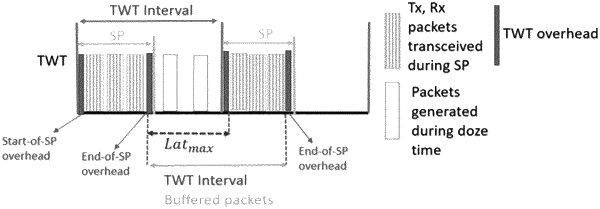| CPC H04W 52/0216 (2013.01) [H04W 52/0232 (2013.01); H04W 72/1263 (2013.01); H04W 74/0816 (2013.01)] | 21 Claims |

|
1. A communication device comprising:
a transceiver configured to transmit and receive higher layer data packets in a target wake time (TWT) operation during an observation time period; and
a processor operably coupled to the transceiver and configured to:
determine, based on physical (PHY) layer transmission and reception data rates during the observation time period, effective higher layer transmission and reception data rates;
estimate an initial data transceiving time of the data packets based on the effective higher layer transmission and reception data rates and total lengths of the transmitted and received data packets;
adjust the initial data transceiving time to obtain a higher layer data transceiving time based on an estimated network congestion level, an estimated required re-transmission rate, and a total amount of TWT overhead during the observation time period; and
determine a new TWT service period and a new TWT interval for the TWT operation based on the higher layer data transceiving time.
|
|
8. A communication device comprising:
a transceiver configured to transmit and receive higher layer data packets in a target wake time (TWT) operation during an observation time period; and
a processor operably coupled to the transceiver and configured to:
determine a minimum duty cycle for the TWT operation that supports a throughput observed during the observation time period, wherein the duty cycle is a ratio of a TWT service period to a TWT interval of the TWT operation; and
jointly determine, based on the minimum duty cycle, a new TWT service period and a new TWT interval for the TWT operation under joint constraints that a latency introduced by the TWT operation does not exceed a maximum latency amount and that the new TWT interval is as large as possible.
|